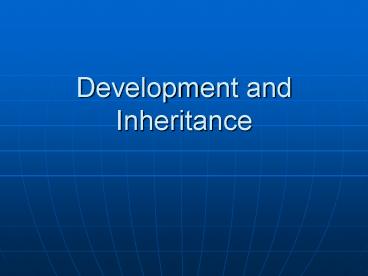Development and Inheritance - PowerPoint PPT Presentation
1 / 70
Title:
Development and Inheritance
Description:
Development and Inheritance Embryo The first two months following fertilization Fetus From week nine until birth Pregnancy Lasts about 40 weeks from the first day of ... – PowerPoint PPT presentation
Number of Views:68
Avg rating:3.0/5.0
Title: Development and Inheritance
1
Development and Inheritance
2
Embryo
- The first two months following fertilization
3
Fetus
- From week nine until birth
4
Pregnancy
- Lasts about 40 weeks from the first day of the
last menstrual period
5
Fertilization
- The genetic material from a haploid sperm cell
and a haploid secondary oocyte merges into a
single diploid nucleus
6
Fertilization
- Occurs in the fallopian tube
7
Fertilization
- Occurs within 12-24 hours after ovulation
8
Fertilization
- There is a total of 3 days per month during
which coitus may result in pregnancy.
9
Fertilization
- Two days before ovulation and one day after
10
Fertilization
- Peristaltic contractions and cilia transport the
oocyte through the uterine tube
11
Fertilization
- Sperm swim up the uterus and uterine tube by
movements of their tails and muscular
contractions of the uterus
12
Fertilization
- Only 200 of the 300 million spermatozoa reach the
oocyte
13
Fertilization
- Capacitation the functional changes that sperm
undergo in the female that allow them to
fertilize an oocyte
14
Fertilization
- A sperm must penetrate the corona radiata and
zona pellucida
15
Fertilization
- Acrosomal enzymes digest a path through the zona
pelucida
16
Fertilization
- The spermatozoa that penetrates the oocyte loses
its tail
17
Fertilization
- Polyspermy is prevented by chemical changes that
penetrate a second sperm from entering the oocyte
18
Fertilization
- Once a sperm enters a secondary oocyte, the
oocyte completes meiosis
19
Fraternal Twins
- Produced from the independent release of two ova
and the subsequent fertilization of each by
different spermatozoa
20
Monozygotic twins
- Derived from a single fertilized ovum that splits
at an early stage in development
21
Formation of the Morula
- Cleavage early rapid mitotic cell division of a
zygote
22
(No Transcript)
23
Formation of the Morula
- Blastomeres - The cells produced by cleavage
24
Formation of the Morula
- Morula A solid mass of 16-32 cells
25
(No Transcript)
26
Development of the Blastocyst
- The morula moves down the ciliated uterine tube
and into the uterine cavity
27
Development of the Blastocyst
- The morula develops into a blastocyst
28
(No Transcript)
29
Development of the Blastocyst
- Blastocyst a hollow ball of cells that is
differentiated into a - Trophoblast
- Inner cell mass
- blastocele
30
Development of the Blastocyst
- Implantation The attachment of a blastocyst to
the endometrium seven to eight days after
fertilization
31
(No Transcript)
32
Development of the Blastocyst
- The trophoblast secretes human chorionic
gonadotropin
33
Development of the Blastocyst
- hCG rescues the corpus luteum from degeneration
and sustains its function
34
Development of the Blastocyst
- Trophoblast becomes the chorion
35
Development of the Blastocyst
- Chorion a membrane outside the amniotic sac
that has villi which project into the placenta
36
Beginnings of Organ Systems
- Gastrulation inner cell mass of the blastocyst
differentiates into three primary germ layers
37
Development of the Blastocyst
- Three primary germ layers
- Ectoderm
- Mesoderm
- Endoderm
38
Embryonic Membranes
- Lie outside the embryo and protect and nourish
the embryo and later, the fetus
39
Embryonic Membranes
- Yolk sac
- Amnion
- Chorion
- allantois
40
Yolk Sac
- It gives rise to cells that migrate to the gonads
to become spermatogonia and oogonia (ICM)
41
Amnion
- Surrounds the embryo creating a cavity filled
with amniotic fluid (ICM)
42
(No Transcript)
43
Chorion
- Derived from the trophoblast
44
Chorion
- Surrounds the embryo and later, the fetus
45
Chorion
- Embryonic part of the placenta
46
(No Transcript)
47
Allantois
- Small vascularized membrane (ICM)
48
Allantois
- Umbilical cord
49
(No Transcript)
50
Umbilical cord
- Vascular connection between mother and fetus
51
Umbilical Cord
- Consists of two umbilical arteries carrying
dexoygenated fetal blood to the placenta and one
umbilical vein that carries oxygenated blood from
the placenta into the fetus
52
Placenta
- Developed by the third month of pregnancy
53
Placenta
- Formed by the
- Chorion (embryonic portion)
- Decidua basalis (maternal portion)
54
(No Transcript)
55
Placenta
- All exchanges to and from the embryo occur here
56
Placenta
- Stores nutrients and released into fetal
circulation as required
57
Hormones of Pregnancy
- During the first 3-4 months of pregnancy, the
corpus luteum secretes progesterone and estrogen
58
Hormones of Pregnancy
- Progesterone and estrogens maintain the uterine
lining and prepare the mammary glands to secrete
milk
59
Hormones of Pregnancy
- After the third, the placenta secretes estrogen
and progesterone
60
Hormones of Pregnancy
- Estrogen inhibits prolactin, so lactation does
not occur
61
Hormones of Pregnancy
- Estrogen increases the number of oxytocin
receptors in the uterus
62
Hormones of Pregnancy
- Relaxin softens the cervix and relaxes the
pubic symphysis to facilitate delivery
63
Hormones of Pregnancy
- Corticotropin-releasing hormone the clock that
establishes the timing of birth
64
Anatomical and Physiological Changes During
Pregnancy
- CO, HR, and SV increases
65
Anatomical and Physiological Changes During
Pregnancy
- Breast enlargement
66
Anatomical and Physiological Changes During
Pregnancy
- Increase in appetite
67
Anatomical and Physiological Changes During
Pregnancy
- Increase in tidal volume and total body oxygen
consumption
68
Anatomical and Physiological Changes During
Pregnancy
- Increase in GFR
69
Anatomical and Physiological Changes During
Pregnancy
- Increase in frequency of urination
70
Anatomical and Physiological Changes During
Pregnancy
- Some women experience elevated blood pressure

